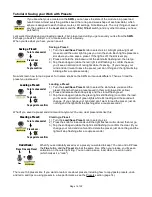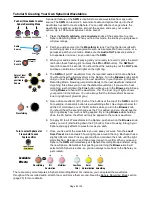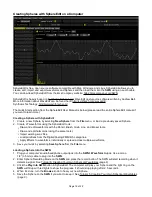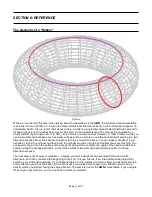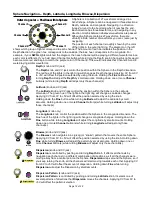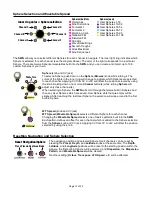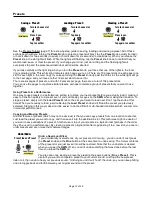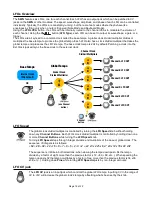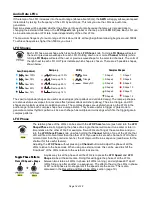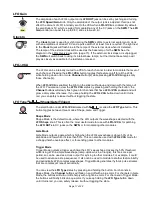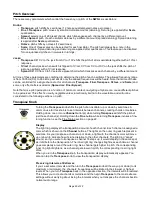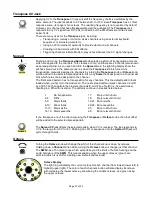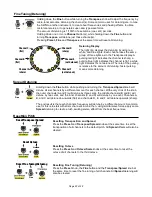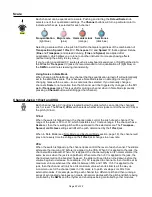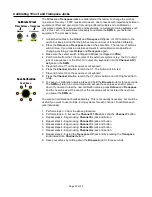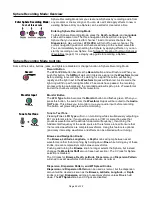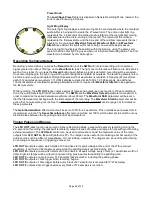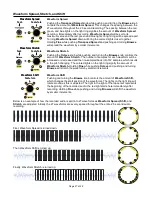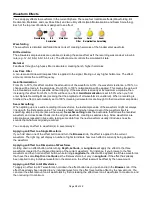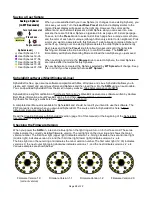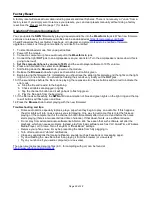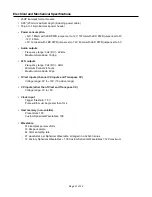
Transpose CV Jack
Applying CV to the
Transpose
CV jack will shift the frequency of all six oscillators by the
same amount. The jack responds to CV between 0V to +10V; since
Transpose
has a 1V/oct
response curve, its range is ten octaves. The resulting frequency is not quantized by default.
However, any channel that has a
Scale
selected will be quantized. The
Transpose
jack
responds to any CV signal from DC (0Hz) to 20kHz, but the FM effects are more diverse
below 1kHz.
There are many uses for the
Transpose
jack, including:
• Transposing a melody or chord on all six channels using an external keyboard,
sequencer, or stair-step waveform.
• Using an LFO (internal of external) to provide vibrato on all channels.
• Creating rich harmonics with FM effects.
• Triggering channels in Note Mode to play notes whenever the CV signal changes.
Spread
Pushing and turning the
Transpose
/
Spread
knob selects a pattern of transposition amounts
which are applied to the channels. This creates a chord, and there are 26 chords (also known
as spread patterns). As you push and turn the
Spread
knob, the light ring displays how the
pitches spread out in the same manner as when the
Transpose
knob is turned. Any
transposition manually assigned to channels by turning the
Transpose
knob or
Octave
knob
will be added to the selected spread pattern. Also, any
Scale
that’s assigned to a channel will
limit which notes can be assigned to the channel.
The first spread pattern has no transposition for any channels. This the default pattern that’s
loaded when you first turn the module on. The next spread pattern raises channels C and D
by a fifth. The third pattern then lowers channels E and F by a fourth (i.e. five semitones),
resulting in a fifth with inversion. The patterns continue in a series listed below:
1:
No transposition
17:
Major ninth chord
2-4:
Fifths
18:
Major eleventh chord
5-7:
Major thirds
19-21: Minor sixths
8-10: Minor thirds
22-24: Minor sevenths
11-13: Major sixths
25:
Minor ninth chord
14-16: Major sevenths
26:
Minor eleventh chord
If you transpose one of the channels using the
Transpose
or
Octave
knobs, then that offset
will be added to the selected spread pattern.
The
Spread CV
jack offsets the selected pattern when CV is received. The jack responds to
CV in the range from 0V to +5V. Patching an LFO or sequencer into the
Spread CV
jack will
cycle through chords.
Octave
Turning the
Octave
knob will change the pitch of the channels up or down by octaves.
Holding down a
Channel
button while turning the
Octave
knob will change just that channel.
The
SWN
has a 15 octave range which extends beyond the limits of human hearing and the
audio hardware of the
SWN
. This creates aliasing when the upper octaves (green) are
selected (which is useful for creating new timbres and textures).
Octave Display
The light ring will display the current octave for each channel from lowest (lower left) to
highest (upper right). The color of each channel’s button will also display its octave,
with red being the lowest octave, yellow being the middle octaves, and green being
the upper octaves.
Page of
21
32
Spread
Octave
Scale
Spread CV

